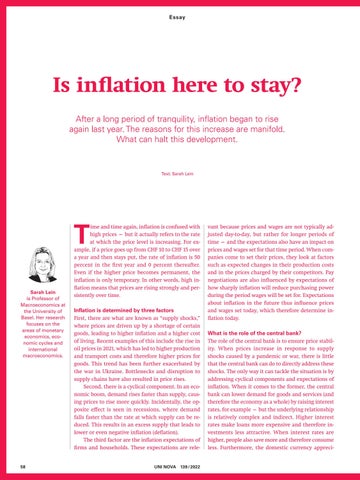Essay
Is inflation here to stay? After a long period of tranquility, inflation began to rise again last year. The reasons for this increase are manifold. What can halt this development.
Text: Sarah Lein
T Sarah Lein is Professor of Macroeconomics at the University of Basel. Her research focuses on the areas of monetary economics, economic cycles and international macroeconomics.
58
ime and time again, inflation is confused with high prices — but it actually refers to the rate at which the price level is increasing. For example, if a price goes up from CHF 10 to CHF 15 over a year and then stays put, the rate of inflation is 50 percent in the first year and 0 percent thereafter. Even if the higher price becomes permanent, the inflation is only temporary. In other words, high inflation means that prices are rising strongly and persistently over time.
Inflation is determined by three factors First, there are what are known as “supply shocks,” where prices are driven up by a shortage of certain goods, leading to higher inflation and a higher cost of living. Recent examples of this include the rise in oil prices in 2021, which has led to higher production and transport costs and therefore higher prices for goods. This trend has been further exacerbated by the war in Ukraine. Bottlenecks and disruption to supply chains have also resulted in price rises. Second, there is a cyclical component. In an economic boom, demand rises faster than supply, causing prices to rise more quickly. Incidentally, the opposite effect is seen in recessions, where demand falls faster than the rate at which supply can be reduced. This results in an excess supply that leads to lower or even negative inflation (deflation). The third factor are the inflation expectations of firms and households. These expectations are rele-
UNI NOVA
139 / 2022
vant because prices and wages are not typically adjusted day-to-day, but rather for longer periods of time — and the expectations also have an impact on prices and wages set for that time period. When companies come to set their prices, they look at factors such as expected changes in their production costs and in the prices charged by their competitors. Pay negotiations are also influenced by expectations of how sharply inflation will reduce purchasing power during the period wages will be set for. Expectations about inflation in the future thus influence prices and wages set today, which therefore determine inflation today. What is the role of the central bank? The role of the central bank is to ensure price stability. When prices increase in response to supply shocks caused by a pandemic or war, there is little that the central bank can do to directly address these shocks. The only way it can tackle the situation is by addressing cyclical components and expectations of inflation. When it comes to the former, the central bank can lower demand for goods and services (and therefore the economy as a whole) by raising interest rates, for example — but the underlying relationship is relatively complex and indirect. Higher interest rates make loans more expensive and therefore investments less attractive. When interest rates are higher, people also save more and therefore consume less. Furthermore, the domestic currency appreci-
















